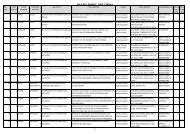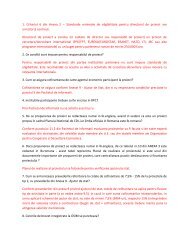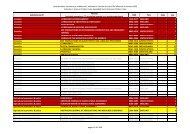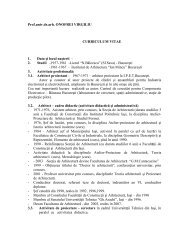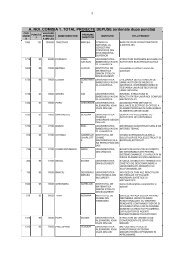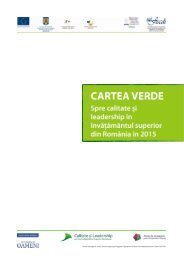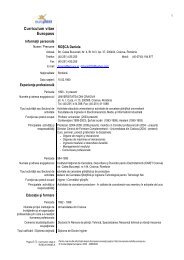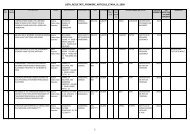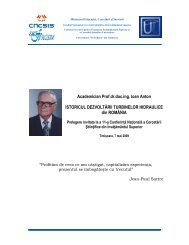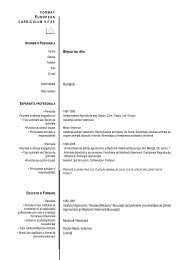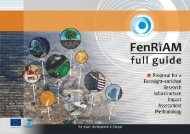"For a technology company like Oxford Catalysts, intellectual property protected by patents is akey asset for building the business"Tiancun Cost: Patent agents and translators Patent office fees, including renewal fees Legal fees if you need to enforce your patent in court Benefit: Essential to attracting investors• Create state-of-the-art facilities• ecruit top scientists• Cover development cost Enables licensing the technology in exchange for royaltiesFurther informationFor further information refer to:http://www.isis-innovation.comhttp://www.oxfordcatalysts.comor contact Terry Pollard:terry.pollard isis.ox.ac.ukThe 3 rd stream activities in direct connection with academic activitiesacademic curricula development according to maret needs (surveys, seminars, worshops, worforcedevelopment programmes)Research evelopment co-operation (achelor, Master, Ph ) student proects, placements3rd party stream impact in academia (new product presentations, practical placement) irect involvement in the everyday life of the universityStudy case examples of how this is done ( egCurriculum oards, Faculty Council)cademic Curricula evelopmentIn countries of the developed world education and scientific research have in most cases been atthe forefront of national development efforts and innovations. Here, there was always closeproximity between ongoing academic efforts and various industrial outcomes. In fact, industrieshad always flourished around colleges and university campusesliving examples in the US includeindustrial parks such as esearch Triangle Park (TP) in North Carolina, and Silicon Valley inCalifornia. It has been through academic research, in great part, that western industries havesustained their pace of growth, where in most cases military research took the lead.Industrial economies have it that in order to lead sustainable growth academic-industrialcollaboration must exist at significant proportions. Under economies like these research budgets,be it directly through the academia or via funding coming in from supporting industries, have hit avisible share in the GNP of the underpinning economies involvedin a number of cases researchbudget allocations exceeded the 5-7 mark of the gross GNP.In the industrial world it is industrial-academic collaboration that contributes significantly tomarket forces: Industries provide openings in the job market while universities pump out theprofessional workforce to fill in the eminent needs. Here, various industries together withacademic entities shape up the job market according to prevailing economic needs. From this, it isquite evident how academic institutions would tailor their curricular offerings to fulfill the marketneeds based directly on input from the industries involved.3435In less developed countries, in general, and the developing world, in particular, the whole pictureis totally different in most cases one would find little, if any, industrial-academic collaborationtaking place. In fact, the prevailing market forces and the holist industrial model are quitedifferent. Here, universities are always in some sort of a race in trying to build a model ofcollaboration with the industry like the one usually found in more developed countries. But for along time, now, most of these efforts did not bear much fruits.This is attributed, in large part, to the level of predominant industries, which are mainly of thelight or transformational type, where academic research efforts undertaken usually strive toemulate something that might well suite a totally different economic model. It had always beenthe case under regimes like these that research efforts expended do not directly match the localmarket needs, but, instead, could be better suited, if any, to more developed economies.Due to the lack of the type of collaboration between the incumbent industries and local academicinstitutions in the developing world that would foster a marked economic growth, universitysystems and indigenous industries would always find themselves falling prey to a catch 22situationeach party would always blame its faltering on the other or on outside forces, who, byconspiracy theory, are thought to have planned all types of economic disarrays for the country inquestion.As a result, market forces in the developing world play out differently Where the local marketneeds take on a certain shape, universities are only graduating people who would have been okayuntil a decade and a half ago or those, based on the curricular offerings they undertook, whowould inadvertently suite some other job market Worse yet, curricular offerings at a goodnumber of academic institutions had gone obsolete since they neither satisfied the local marketneeds nor did they undergo tangible reviews to keep them current. This is further complicated bythe fact that many of the university systems in these countries do not run industry-grade researchto satisfy the needs of the local industries, for without significant valid research, teachingstandards would continue to be on the decline. This has manifested itself quite drastically in arecent survey conducted by the Times Higher Education Supplement to rank the top 200 worldinstitutions, where most universities in the developing world showed a marked absence from thelistings.The role of an academic entity towards improving educational outcomes under a particulardiscipline usually takes an early start in the processin particular, its role starts right about thestage of admitting the student into his/her desired program of study. Universities usually admitstudents into their programs of study based on their achievement in the final year of high school.Countries that have fully developed educational systems confidently rely on the studentachievements in the high school achievement tests, or equivalents thereof. In less developed ordeveloping countries, the High School (or secondary school) achievement tests do not usually trulyreflect the actual potentials for student candidacy to gain admission in a university system. Assuch, countries like these could possibly resort to international assessment and evaluation bodiesto gauge student potentials, capabilities, and suitability for admission into a university system.Even in well developed nations like the United States you would find students undergoingassessment procedures through recognized testing bodies like ETS the Standard Aptitude Test(SAT) is one of the instruments US academic institutions rely on for admitting students intoeducational systems at the tertiary level. However, in a number of cases internationallyrecognized/standardized testing processes might not rightly be well suited for countries whoselanguages of instruction are different from that of the assessing bodies. For these reasons,amongst others, countries like these have lived with their own methods of assessing students foruniversity entry. In time, assessment processes like these tend to become obsolete and do notserve the purpose for lack of a proper review and system update due to the limited resources ofthe underpinning economies of these countries.Finally, universities ought to bring about some level of flexibility and malleability in their curricularplanning by allowing room for an ongoing review process of their various curricula to keep themup-to-date with the rapidly changing market directions, and, where possible, use feedback fromthe market and/or conduct periodic market surveys locally, regionally and globally, andincorporate the results of their findings towards re-designing their curricula to stay abreast withthe rapidly changing market needs.Implementation in ResearchIn the next section we propose a visionary model which could serve as the long-awaited gateway/sfor the formation of some industrial base/s that would fulfill the ambitions of communities thathave long aspired to have some significant stake towards building some form of sustainableeconomies for their societies.3637
To overcome the difficulties occurring as a result of foreign competition, which usually impede anyreal economic growth and stand in the ways of any technology yield and export, in third worldcommunities, we propose the model shown in Figure 1 below:Today, no industry can survive without D, which cannot be separated from ongoing researchefforts at academic institutions. For that reason, you tend to find huge industrial parks clusteredaround major academic concentrations. In the United States, for instance, esearch Triangle Parkin North Carolina and Silicon Valley in California are living examples of the close coupling betweenthe academic and industrial sectors. Here researchers from the academia can receive funding fromthe industry for their projects, and people who are affiliated with D departments aroundindustries find it quite handy to collaborate with academic researchers. oreover, universitiesnowadays rely heavily on industries for entertaining their interns.ob markets anywhere around the world are governed primarily by the needs of the industrial andservice sectors. Hence, in well developed academic programs, the various curricula are usuallygeared towards fulfilling the needs of these sectors. As industries evolve, academic institutionscontinually go about curricular reviews using feedback coming in from the industries involved. Thisserves both ends of the spectrum: fresh university graduates are better suited for the prevailingmarket needs and better prepared to readily be productive on the joband industries no longerneed to allocate significant budgets to train these new university graduates.Study CaseFigure 1: A Proposed odel to Achieve Integration for an Industry-Supported EconomyThe diagram of Figure 1 is a conglomeration of a number of various components that by natureare closely coupled in an already industry-based economy, which need to be so in countriesaspiring to achieve sustainable development based on some industrial base. In the less developedworld and countries of the third world, the picture shown in the diagram could be, at present,significantly different with varying degrees from one country to another.In the industrial world, industry and academia have traditionally been closely intertwinedindustryhas had a marked presence in areas of significant academic concentrations, where academiaalways contributed their much needed consultation and D services. To receive solutions fromthe academic sector, industrialists were always supportive of academic research efforts throughdirect funding, or by supporting lab facilities and equipment to researchers. orthern entucy niversity (http://access.nku.edu/oca/needsassessment.htm ) encourages thedevelopment of new and innovative academic programs which advance its mission. Thedevelopment of new programs is facilitated by the University Curriculum Committee (UCC) andthe Office of Curriculum, Accreditation and Assessment (CAA). CAA and UCC will provide supportand counsel for individuals seeking approval of proposals.The UCC review process contributes to the quality of the proposed programs and increasestheir probability of success. It is the only pathway permitted by the Board of egents for theapproval of new academic programs.Working with the UCC, the program sponsors prepare a packet of materials about theproposed program which includes technical assistance and advice from several offices on campus:The Office of Curriculum, Accreditaiton, and Assessment to assure that the program fits within theparameters of SACS and state guidelinesThe directors of computing services, media, and the libraries to predict the impact of the programon learning resources383The Office of Provost to analyze the financial impact of the proposed program.Prior to submitting the Academic Planning Form, the department proposing the newacademic program must conduct a needs assessment to determine the market for the program.The proposing department must provide evidence of both student need and ample employmentopportunities exist for program graduates. arket Needs AssessmentA market needs assessment must be conducted by the program sponsor with assistance. Themarket needs assessment must include, but not necessarily be limited to, market analysis ofstudent demand, employer needs assessment, market position and competition, and marketpotential.Documentation of Need for ProgramPlease provide objective data, studies, or the results of institutional needs assessmentconducted to document a special need. Use any of the following possible justifications, asappropriate to the programs nature:1. Student interest or demand.2. Cultural, artistic, and intellectual growth.3. Economic growth and development.4. Changes in occupation or profession.5. Workforce needs of local industry. (Please detail whether workforce needs requirefuture graduates or the retraining of present employees and estimate the demand for, and supplyof, graduates.)6. Service to community. (Please describe the potential opportunities for service to thecommunity which program faculty, students, or administrative staff could provide. Include asappropriate, opportunities for research, internships, or service.)Needs Assessment SurveysSample surveys are available which can be modified for individual programs. Surveys are availablein icrosoft Word or online. CAA will work with the department to design the appropriate surveyfor students and/or employers.Employer Survey in Word FormatPotential Student Survey in Word FormatEmployer Survey OnlinePotential Student Survey Online arket Needs Survey Procedures40CAA will do the following:• prepare the surveys and letters• mail or e-mail surveys to potential respondents• analyze the results• The department proposing the academic program will do the following:• determine the target audience for the surveys• provide a list with names and addresses of potential employers• provide a list with names and addresses of potential students• pay for the postage to do the initial mailing of the surveys and for the return postage-paidpostage.41



